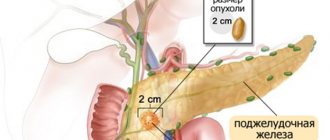Galactorrhea of the mammary gland is the secretion of milk that occurs outside the physiological process of lactation, i.e., not associated with the need to feed the baby. Galactorrhea develops due to dysfunction of the pituitary gland, so it occurs not only in women, but also in men. Milk secretion occurs due to hyperprolactinemia - an increase in the level of prolactin in the blood. Statistics regarding the prevalence of the pathology vary greatly. Depending on the methods used, researchers cite figures from 0.1 to 32%.
In the first weeks after birth, nipple leakage may occur in infants due to the fact that they received estrogen through the placenta during fetal development. This phenomenon does not require medical intervention and, as a rule, goes away on its own. It is observed in approximately 6% of newborn girls and boys.
The discharge of a thick viscous fluid (colostrum) from the nipples of women in the last stages of pregnancy is also not an anomaly.
Reasons for development
The most common cause of the disease is a tumor of the pituitary gland, which promotes increased production of prolactin, a hormone that stimulates milk production. Also, milk discharge from the nipples can be observed due to:
- Diseases of the thyroid gland. Most often, this is hypothyroidism, in which the level of thyrotropin-releasing hormone increases, which increases the level of prolactin.
- Taking medications that reduce the level of dopamine, a hormone whose function is to control the release of prolactin. Also, drug-induced galactorrhea can develop due to taking drugs that block sensitivity to dopamine. Taking estrogen-containing oral contraceptives can also lead to the development of the disease (estrogen increases prolactin levels).
- Lesions of the hypothalamus. When dopamine-releasing neurons are destroyed, the amount of prolactin automatically increases. The same thing happens when the pathways through which dopamine is transmitted to the pituitary gland are disrupted.
- Kidney failure. A decrease in the level of renal clearance of prolactin also provokes milk leakage.
- Disorders of neuropsychic reactions as a result of stress or increased alcohol consumption.
- Regular physical overload, typical, for example, of professional athletes.
Other possible causes of galactorrhea
Pathologies of the hypothalamus - a brain structure that controls the functioning of the pituitary gland. These may be primary and metastatic tumors, histiocytosis X and other diseases. They are rare. The essence of the disorder is that pathological changes in the hypothalamus disrupt its function, it can no longer restrain the pituitary gland, and it begins to produce excessive amounts of prolactin.
Thyroid gland dysfunction. With primary hypothyroidism, the level of thyroid hormones in the blood drops. The body tries to correct this problem, and the hypothalamus begins to produce more thyroid hormone. This hormone, in turn, stimulates the production of thyroid-stimulating hormone in the pituitary gland. Thyroid-stimulating hormone causes the thyroid gland to work more actively. At the same time, thyrotropin-releasing hormone stimulates the production of prolactin.
Chronic renal failure. It is believed that in such women, the kidneys cannot adequately remove prolactin from the body, and its level in the blood increases. Although this situation occurs in approximately 30% of women suffering from chronic renal failure, it rarely leads to galactorrhea.
Neurogenic causes. If a woman frequently stimulates her nipples during sexual intercourse, or they rub against uncomfortable clothing, impulses arise in the nerve endings that are transmitted to the brain. As a result, the work of the hypothalamus changes, it ceases to have an inhibitory effect on the pituitary gland, prolactin levels increase, and galactorrhea occurs. Most often this occurs in women who have recently given birth to a child. But cases have been described where nipple irritation led to galactorrhea in teenage girls and even men.
A similar situation can occur after chest surgery, burns, spinal cord injuries, and herpes zoster.
Neonatal galactorrhea occurs in newborns if, before birth, they received too many sex hormones - estrogens - from the mother's body through the placenta. Most often this is a temporary condition and soon passes. But sometimes neonatal galactorrhea persists for a very long time.
Taking certain medications. Galactorrhea can be caused by sedatives, antidepressants, antipsychotics, opioids, medications for high blood pressure, herbal remedies with fennel, anise, and fenugreek seeds.
Low testosterone levels are a possible cause of galactorrhea in men. At the same time, libido (sex drive) decreases and erectile dysfunction occurs.
If the underlying cause cannot be determined, idiopathic galactorrhea is diagnosed.
Symptoms
The most common reason for visiting a doctor is milk leaking from the nipples. Persistent galactorrhea is also accompanied by a change in the nature of menstruation (most often towards amenorrhea), the development of frigidity, and excess hair growth. In 30–60% of cases, galactorrhea accompanies the symptom of polycystic ovaries. Patients of both sexes develop depression, acne, pigmentation, seborrhea, and frequent headaches. Men experience erectile dysfunction and loss of interest in sexual activity.
If the discharge from the breast has a reddish tint, this is most likely not galactorrhea, but a sign of developing cancer.
Galactorrhea: what tests to take
If you notice smudges on the inner surface of your bra cups, you should immediately consult a doctor. And the sooner this is done, the sooner a diagnosis will be made and treatment will begin. You should be especially wary if the nipple discharge is not milky in appearance: in this case, the problem may turn out to be completely unfavorable.
If galactorrhea is suspected, the gynecologist begins an examination - hormone tests and ultrasound. The purpose of the examination is to exclude pregnancy and discover the cause of the increase in prolactin.
Several organs need to be examined by ultrasound:
- An abdominal ultrasound is performed to rule out liver or kidney failure. At the same time, a biochemical blood test is performed.
- Pelvic ultrasound - the ovaries are examined for the presence of cysts. At the same time, a blood test is taken to determine estrogen levels.
- Ultrasound of the thyroid gland. Immediately donate blood to check the level of thyroid hormones, TSH.
To diagnose brain tumors, X-rays, CT scans or MRIs are prescribed (at the discretion of the doctor).
Treatment
The treatment method for galactorrhea and the medications depend on the cause that caused it, as well as on the state of the hormonal level. The main principle of therapy is stabilization of hormonal levels and reduction of prolactin levels. This is achieved by:
- prescribing drugs that inhibit the release of prolactin;
- elimination of the tumor by surgery or radiation therapy;
- treatment of the disease against which galactorrhea developed (for example, endocrine disorder, kidney failure);
- correction of the drug regimen that caused the patient to develop the disease (for example, oral contraceptives).
If nipple leakage is a side effect of taking a drug prescribed to treat another condition, you should not stop the drug yourself. You should immediately inform your doctor about this situation.
Galactorrhea as a manifestation of post-traumatic stress disorder
Post-traumatic stress disorder (PTSD) (F43.1 ICD-10) refers to reactions to an unusual situation experienced that can cause shock in any person (for example, situations that pose an immediate threat to the life or physical usefulness of a person: disasters, road accidents, etc. . P.). This disorder, mainly caused by external circumstances, is often observed in combatants. The patient repeatedly experiences traumatic circumstances in the form of:
- intrusive memories (for example, short-term and vivid re-experiencing of the previous “flashback”, nightmares);
- painful dreams;
- feelings and actions indicating a possible repetition of the traumatic situation;
- severe psychological distress in situations reminiscent of or associated with a traumatic event;
- overexcitement;
- emotional numbness.
Other manifestations of this disorder include persistent avoidance of stimuli that may be associated with a traumatic situation and signs of persistent overreaction. These phenomena are usually not typical for the patient before suffering mental trauma. To make a diagnosis, it is considered necessary to have a latent period between the onset of signs of the disease and the injury itself, lasting at least a month.
Patient E., 27 years old, came to the mammology room of the War Veterans Hospital (WVH) with complaints of uncontrollable lactation from both mammary glands. Has a child aged 3 months. After giving birth, she breastfed the baby for a month, after which lactation stopped; attempts to restore it with the help of a lactogenic diet were unsuccessful.
The patient lived with her husband (her husband was a military man) in a “hot spot” where the situation was very tense. 2 weeks after the cessation of lactation, she was evacuated from the “conflict zone.” The helicopter came under fire along the way and was shot down, but the pilot managed to make it to the base. The patient experienced extreme stress, “already saying goodbye to life.” After the events described, the patient developed a pronounced feeling of anxiety, fear for her life and the life of her child. Anxiety appeared and she began to be frightened by any loud sounds. At night I was bothered by nightmares with a repetition of the helicopter shelling plot. I took Seduxen, the effect was insignificant. A month later, galactorrhea suddenly developed from both mammary glands, caused reflexively: at the sight of a child sucking from a bottle; when frightened by a car horn. Galactorrhea was so profuse that the patient was forced to wear a leather jacket over her naked body in May, when it was already quite warm.
2 weeks before contacting us, she was consulted at the Moscow Breast Center. Bromocriptine (5 mg/day) was prescribed. In the first week of use, she noted a slight decrease in lactation, but then lactorrhea intensified again as a reaction to sound signals.
Upon arrival in Kazan, I went to the mammology office of the GVV Ministry of Health of the Republic of Tatarstan.
Mental status . The patient bursts into the mammologist’s office without an invitation, opening her leather jacket on her chest, with nothing underneath (the consultation took place in May, in warm weather), and pathetically exclaims: “Doctor, I’m asking you, what is this?!” Milk is oozing from both mammary glands, the entire lining of the jacket is wet.
When asked to sit down, he sits on the edge of the chair, then jumps up again, exclaiming: “Doctor, do something!” Then he calms down a little and sets out his “story.”
Sits on the edge of the chair, constantly changes position: cannot sit still.
His facial expressions are lively, he actively helps himself with gestures, constantly unbuttons and opens, then buttons his jacket. Easily moves from smiling to tears.
The speech is accelerated, “pathetic”. The story is replete with details, often jumping from one thought to another: “When we were flying in a helicopter, it was a military helicopter, green, and there was still a terrible smell of fuel in the cabin. You know, my husband loves croutons very much, and I just made them for him that morning, but since we were in a hurry, they got burnt. So, we were flying, and I kept thinking - we’ll make it, we won’t make it. And then suddenly there was a blow, there was a flash in the window, there was a strong smell of smoke, and the engine began to work somewhat intermittently. It was as if everything had been taken away from me, I felt cold, and my whole life, mom, was before my eyes. My mother, by the way, worked as an engineer, a very good person, she helped us a lot...”
Lately he describes his mood as unstable. She has become irritable and finds fault with her husband over trifles. “Then suddenly melancholy comes, tears flow from my eyes, I sit, staring at one point, as if I don’t hear anything around. And then suddenly a car outside the window honks, and such fear takes over, it throws you into the cold, and then the milk just runs in a trickle.” Complains of almost constant headaches, especially at night, and insomnia.
I am constantly haunted by thoughts about the disaster I experienced, mostly at night: “I close my eyes and smell the smoke, and hear the helicopter engine choke, and we all fall.” To get rid of obsessive thoughts, I began to read prayers at night, but it didn’t help: “Maybe because I didn’t believe before?”
She is oriented correctly in time, space and in relation to her own personality.
Attention is distracted. Concentration reduced. When counting according to Crippelin, errors begin from the second action, he thinks for a long time about the result of each action (total time - more than 10 minutes).
Short-term memory: remembering three numbers out of five, after 10 minutes does not remember a single one.
The phrase: “One of the riches that a country must acquire in order to become prosperous and great is a significant and reliable supply of oil” - I was able to reproduce it more or less close to the text after 7 repetitions. Memory for recent events is sharply reduced. Memory for distant events is not changed.
Realizes that the phenomena occurring to her both in the mental and somatic aspects can be classified as abnormal. He considers them a consequence of the stress he has experienced. She asks to prescribe her treatment.
Objective examination . The patient has the correct physique and excess nutrition.
The skin is moderately pale and moist. Dermographism is red and persistent. Tendon reflexes are alive. Moderate exophthalmos. The thyroid gland is diffusely enlarged (grade I diffuse goiter), soft. In the lungs, breathing is vesicular. BH - 20 per minute. Heart sounds are rhythmic. Blood pressure - 80/60 mm Hg. art., heart rate - 92 per minute.
The stomach is soft. Stool - dyspepsia (constipation is replaced by weakness). Diuresis is somewhat excessive (“frequently runs to the toilet”). There are no periods after childbirth.
Status localis . The mammary glands are symmetrical, of a uniform tight-elastic consistency, however, the “tail lobes” on both sides are denser, clearly delimited from the surrounding tissues, and moderately painful on palpation. Even a slight “sliding” palpation of the mammary glands is accompanied by the release of milk in frequent drops from many ducts of both mammary glands.
Laboratory data: PRL - 1117 ng/ml, TSH - 4.6 ng/ml.
The pathogenesis of galactorrhea as a post-traumatic stress disorder, in our opinion, can be explained as follows.
Prolactin plays the main role in stimulating the secretion of the mammary glands. Prolactin is mainly synthesized in the anterior lobe of the pituitary gland by lactotropocytes, which make up 11–29% of the total cellular composition of the adenohypophysis, but small amounts can be secreted by other parts of the brain, as well as mammary glands, T-lymphocytes, the decidua and myometrium, and the epithelium of the small intestine , lung and kidney cancer cells. It is secreted constantly, in the mode of basal and peak secretion. The prolactin molecule consists of 199 amino acid residues with a molecular weight of about 23 kDa. There are other forms of prolactin with a higher molecular weight, namely: glycosylated prolactin with a molecular weight of 25 kDa (accounts for 15–25% of all prolactin); split prolactin; high molecular weight prolactin (molecular weight 50 kDa); ultra-high molecular weight prolactin with a molecular weight of up to 100 kDa. Moreover, various forms of prolactin can exist both in healthy people and in patients with prolactinoma.
The production and secretion of prolactin is stimulated by estrogens, thyroliberin, gonadoliberin, somatoliberin, serotonin, cholecystokinin, oxytocin, neurotensin, vasopressin, galanin, vasoactive intestinal polypeptide and endogenous opiates (NK Kochenour, 1980). In addition, various stressful situations can also cause an increase in prolactin concentrations.
The main factor that inhibits the secretion of prolactin through the D2 receptor system located in the membranes of lactotropocytes is dopamine. The release of prolactin is inhibited by γ-aminobutyric acid, gastrin, somatostatin, gonadotropin-binding peptide, calcium ions, norepinephrine, acetylcholine, as well as stimulation of cholinergic innervation.
Some medications also block the secretion of prolactin: clodipine, nomifesin, apomorphine, ergotamine derivatives (bellaspon), dopamine receptor stimulants (parlodel, bromocriptine, norprolac, dostinex), serotonin antagonists (methysergide, sandomigran, pyritol), monoamine oxidase inhibitors (aurorix, Zoloft) .
There are physiological and pathological hyperprolactinemia. Physiological hyperprolactinemia is observed in women during pregnancy, childbirth and lactation, as well as in newborns.
The causes of pathological hyperprolactinemia are diseases accompanied by dysfunction of the hypothalamus (infections, injuries), damage to the pituitary gland (tumors, adenomas, “empty sella” syndrome). Moreover, this form of hyperprolactinemia occurs most often. In the general population, this condition is observed in 0.5% of cases in women and 0.07% in men. Young women aged 25–40 years are most affected.
The most common (50%) causes of hyperprolactinemia are pituitary adenomas that secrete prolactin. In 30% of cases, idiopathic hyperprolactinemia is observed, in which there are no changes in the area of the sella turcica.
With pathological hyperprolactinemia, along with changes in the mammary glands, menstrual dysfunction occurs, galactorrhea, infertility, libido disorders, and diencephalic disorders develop. Moreover, a distinction is made between secondary, or functional, pathological hyperprolactinemia, in which there are no organic lesions of the pituitary gland.
It accounts for 12–45% of all cases. The cause of the development of this abnormality may be: hypothyroidism (9–88% of cases), polycystic ovary syndrome (11–30%), menopausal syndrome (10–15%), adrenal insufficiency, ectopic secretion of hormones, chronic renal failure, liver cirrhosis, herpes zoster lichen, intrauterine contraception, exposure to toxic factors, chronic stress.
In 15–30% of cases, hyperprolactinemia is combined with other endocrine disorders, namely hyperandrogenism, hypothyroidism, and chronic stress (I. I. Dedov, G. A. Melnichenko, 1985).
An increase in hormone levels causes swelling, engorgement and tenderness in the mammary glands during the second phase of the menstrual cycle or immediately before menstruation. Autonomic manifestations may be observed, namely migraine-like headaches, swelling of the extremities, pain and bloating in the abdomen. This symptom complex is called premenstrual syndrome. A constant increase in prolactin concentration is a chronic stimulant of the mammary glands.
There are reports by N. T. Sturua (1982) that in most patients with diffuse mastopathy, the prolactin content reaches the upper limit of normal. At the same time, N.I. Lazarev (1974) indicates a normal level of prolactin in the majority of patients with mastopathy. According to other data (I.I. Dedov, G.A. Melnichenko, 1985), the majority of patients with mastopathy have hyperprolactinemia in combination with dysfunction of the thyroid gland. V. N. Serov et al. (1998) with hyperprolactinemia did not reveal any peculiarities in the secretion of T3, T4 and TSH, which indicates normal functioning of the thyroid gland.
According to the theory of G. Selye, stress, both acute and chronic, leads to tension in catecholamine mediation in the central nervous system and increased production of “fight hormones” by the adrenal glands. Long-term stress leads to depletion of catecholamine resources, including dopamine, on the one hand, and to an increase in the secretion of releasing factors by the hypothalamus and tropic hormones by the pituitary gland according to the feedback principle, on the other.
Dopamine deficiency causes the appearance of asthenic-depressive symptoms in the mental sphere, and in the somatic sphere, in particular, increased lactation, since its antagonistic effect in relation to prolactin, the synthesis of which, as already mentioned, is already increased, decreases.
Our patient was prescribed the following treatment: parlodel - 2.5 mg 2 times a day, mastodinone - 30 drops. 2 times a day, coaxil - 12.5 mg 3 times a day, alprazolam - 500 mcg at night.
At a control visit after 1 month: colostrum discharge from the mammary glands, one drop from several ducts.
The patient noted an improvement in her general condition, the cessation of nightmares and obsessive thoughts about the disaster. My relationship with my husband has improved. Menstruation appeared and her cycle was restored. PRL - 368 ng/ml.
Taking into account the decrease in plasma prolactin concentration to normal and the restoration of menstruation, the dose of parlodel was reduced to 2.5 mg/day (in the morning). A follow-up examination was recommended after 2 months, but the patient appeared only a year later. All this time she was observed by endocrinologists in Kiev, where her husband was transferred for work. There she underwent additional studies of the pituitary gland (NMR), but no data indicating the presence of an adenoma were found. The concentration of prolactin in plasma remained within normal limits throughout this time. Unfortunately, further observation of the patient was not carried out.
Thus, it is known that lactation can stop under the influence of acute stress due to an increase in the concentration of dopamine in the plasma and the inhibition of prolactin by the latter. However, we also found that over time, with the formation of post-traumatic stress disorder and depletion of dopamine resources, galactorrhea can develop (as in the described case) due to a decrease in the antagonistic effect of dopamine on prolactin. Timely comprehensive treatment can relieve the symptoms of the disease and improve the patient’s quality of life.
Literature
- Epstein RS Posttraumatic stress disorder: A review of diagnostic and treatment issues // Psychiatric Ann. - 1989. - V. 19(10). — P. 556 — 563.
- Helzer JE, Robins LN, McEvoy L. Posttraumatic stress disorder in the general population: Finding of the epidemiologic Catchment Area Survey // N. Engl. J. Med. - 1987. - V. 317(26). - P. 1630 - 1634.
- Shore JH, Vollner WM, Tatum EL Community patterns of post-traumatic stress disorder // J. Nerv. Ment. Dis. - 1989. - V. 177. - P. 681 - 685.
- Silver JM, Sandberg DP, Hales RE New approaches in the pharmacotherapy of posttraumatic stress disorder // J. Clin. Psychiatry. — 1990. —V. 51(Suppl. 10). - P. 33 - 38.
- Ognerubov I. A. Mastopathy: possibilities of conservative therapy. - Voronezh, 2001. - 136 p.
- Case history of a mentally ill patient: Method. recommendations / Comp. D. M. Mendelevich, K. K. Yakhin. - Kazan: Publishing house KSMU, 2002. - 42 p.
- Selye G. At the level of the whole organism: Trans. from English - M.: Nauka, 1972. - 122 p.
D. Yu. Ustimov B. K. Druzhkov , Candidate of Medical Sciences, Associate Professor R. F. Zakirov , Candidate of Medical Sciences KSMU, Kazan
Frequently asked questions about galactorrhea
How does galactorrhea manifest?
A characteristic symptom is discharge from the nipples of a milky color and consistency. They can occur in both women and men. In some cases, engorgement of the mammary glands and discharge from them are observed in newborns. This condition is not a pathology and does not require treatment.
Why is galactorrhea dangerous?
The main danger of the condition lies in the reason that led to it. Most often, this is a tumor of the pituitary gland, as a result of which the hormonal levels change and the functioning of the entire body is disrupted. Nipple discharge can be caused by malignant neoplasms or kidney problems.
What happens if galactorrhea is not treated?
Without treatment, the disease that caused the discharge progresses.
How is galactorrhea treated?
1. Surgical methods.
If the cause of discharge from the mammary glands is a tumor, then only by removing it can recovery be ensured.
However, it is worth understanding that any surgical intervention on the brain is very dangerous and largely depends on the experience and skill of the neurosurgeon. Therefore, surgery is a last resort. It is much easier to treat PCOS, ovarian and adrenal tumors. But even here the risk of reproductive dysfunction is high, so hormone replacement regimens are used first. If they prove ineffective, the doctor moves on to radical options. 2. Conservative methods.
Therapeutic treatment with tablets is quite possible, especially if treatment is started at the beginning of the disease. Disorders associated with hypofunction of the thyroid gland are well treated with hormones.
To treat this condition, courses of special medications are used, which are used to suppress lactation in those women who, for one reason or another, cannot breastfeed.
Breast discharge in non-breastfeeding women
10.09.2021
nipple discharge may be caused by mastopathy, intraductal papilloma or breast cancer .
Discharge from the mammary glands is observed from both nipples or from one milk duct. During the examination, the doctor needs to find out
the nature of the discharge (milky, hemorrhagic, serous), whether they are released independently or with pressure, what is the reason for their appearance -
constantly or during menstruation , whether a neoplasm is observed in the mammary gland . The question of the patient’s use of hormonal contraception is very important.
Spontaneous discharge from only one nipple of the single milk duct may indicate intraductal papilloma, less often -
for intraductal breast cancer . The tumor itself may not be palpable. Diagnosis includes cytological
study of secretions and ductography. Regardless of the nature of the tumor (benign or malignant), treatment is surgical.
Spontaneous discharge from the mammary glands (brown or greenish in color) in women of reproductive age, associated
with menstruation , as a rule, occur with mastopathy. In cases where there is no formation in the mammary gland and no affected duct is detected,
Prescribe weekly palpation of the glands and mammography. Prolonged discharge becomes a reason for a biopsy.
Galactorrhea is the secretion of colostrum or milk from the mammary glands. Galactorrhea is normal during pregnancy and childbirth
Pathology can be suspected if it is not associated with lactation and lasts more than five months after the child has finished feeding. It has long been known that
Several hormones - prolactin , somatotropin, thyroxine, cortisol, as well as insulin and estrogens secreted in the ovaries .
Galactorrhea can vary in severity - from periodic small discharge to heavy and regular discharge.
Considering that lactation is regulated by hormones , several reasons for the occurrence of galactorrhea can be named. And yet, often the reason remains unclear.
This type of discharge is called idiopathic galactorrhea. This condition is provoked by pituitary , dysfunction of the hypothalamus,
uncontrolled use of medications (morphine, chlorpromazine, oral contraceptives), pathologies of the thyroid gland , reflex activation and
ovarian diseases .
A large number of reasons that can cause galactorrhea require careful examination. As a rule, it begins with an examination of the patient and anamnesis.
( infertility , assessment of kidney and liver , menstrual irregularities). hormone levels is required . In some cases
an MRI, an X-ray of the skull, an ultrasound of the mammary glands and abdominal organs are required. After identifying the cause of galactorrhea, its possible elimination is carried out.
If no obvious cause can be found, the patient is prescribed drugs that reduce the level of prolactin in the blood - norprolac, bromocriptine and dostinex.
Published in Mammology Premium Clinic
Causes
Galactorrhea appears due to:
- overstimulation of the nipples;
- hypothyroidism – lack of hormones (secreted by the thyroid gland);
- consuming herbs in large quantities: nettle, anise, thistle;
- use of certain medications: tricyclic antidepressants, reserpine, opiates;
- malignant lung tumor – bronchogenic cancer;
- pathology of the pituitary gland.
It is known that galactorrhea, the causes of which have been identified, requires immediate treatment.
Infertility with persistent galactorrhea-amenorrhea syndrome
As we wrote above, infertility is often the reason a woman turns to a specialist. In addition, it is also possible to terminate a spontaneous pregnancy in the early stages (up to ten weeks). Thus, treatment of the syndrome in this case aims to restore reproductive function in patients.
If you have any questions related to galactorrhea-amenorrhea syndrome, you can ask them to the doctors at Nova Clinic.
In order to avoid dangerous complications, it is very important to diagnose the pathology in a timely manner and undergo a course of treatment. You can make an appointment with a doctor by calling the number listed on the website or using the booking button.
Complications of breast galactorrhea
By not paying attention to the symptoms of galactorrhea in the chest, you can miss the development of a complex disease with serious consequences:
- In case of diseases of the endocrine system, the patient may fall into a hypothyroid coma. The fluid is not removed, which leads to swelling of the lungs, brain and heart. Quickly lowers blood pressure, the level of hormones in the blood drops.
- Pathology of the pituitary gland or hypothalamus causes increased intracranial pressure, which leads to headaches, blindness, and stroke. This can lead to cancer.
- If the formation is present in the lungs, metastatic lesions can develop in a very short time.
Breast lactation is not considered dangerous. And yet, under certain circumstances, the development of pathology threatens with unpleasant consequences:
- Infertility. Elevated prolactin is characterized not only by stimulation of lactation, but also by inhibition of ovulation, as a result of which pregnancy does not occur.
- Chorionic carcinoma. If, despite pathology, you manage to get pregnant, there is a risk of losing the fetus as a result of cancer.
Links[edit]
- ^ab Sakiyama, R.; Quan, M. (1983). "Galactorrhea and hyperprolactinemia." Obstetric and gynecological examination
.
38
(12): 689–700. DOI: 10.1097/00006254-198312000-00001. PMID 6361641. S2CID 2846310. - Whitman-Elia, G.F.; Windham, N. Q. (2000). “Galactorrhea can be a clue to serious problems. Patients deserve a thorough assessment." Graduate School of Medicine
.
107
(7): 165-168, 171. DOI: 10.3810/pgm.2000.06.1129. PMID 10887453. - Rohn, R. D. (1984). "Galactorrhea in adolescence." Journal of Adolescent Health
.
5
(1): 37–49. DOI: 10.1016/s0197-0070(84)80244-2. PMID 6420385. - Karimi, H; Nourizad, S; Momeni, M; Rahbar, H; Momeni, M; Farhadi, K. (2013). "Burns, hypertrophic scar and galactorrhea". Journal of Trauma and Violence Research
.
5
(2): 117–9. DOI: 10.5249/jivr.v5i2.314. PMC 3683415. PMID 23456048. - Popli, A (March 1998). "Risperidone-induced galactorrhea associated with increased prolactin levels." Ann Klin Psychiatry
.
10
(1):31–3. DOI: 10.3109/10401239809148815. PMID 9622047. - Jump up
↑ Potts, Malcolm (1999). Since Adam and Eve: The Evolution of Human Sexuality. paragraph 145. ISBN 0-521-64404-6.
- which may also indicate a pituitary gland disease










